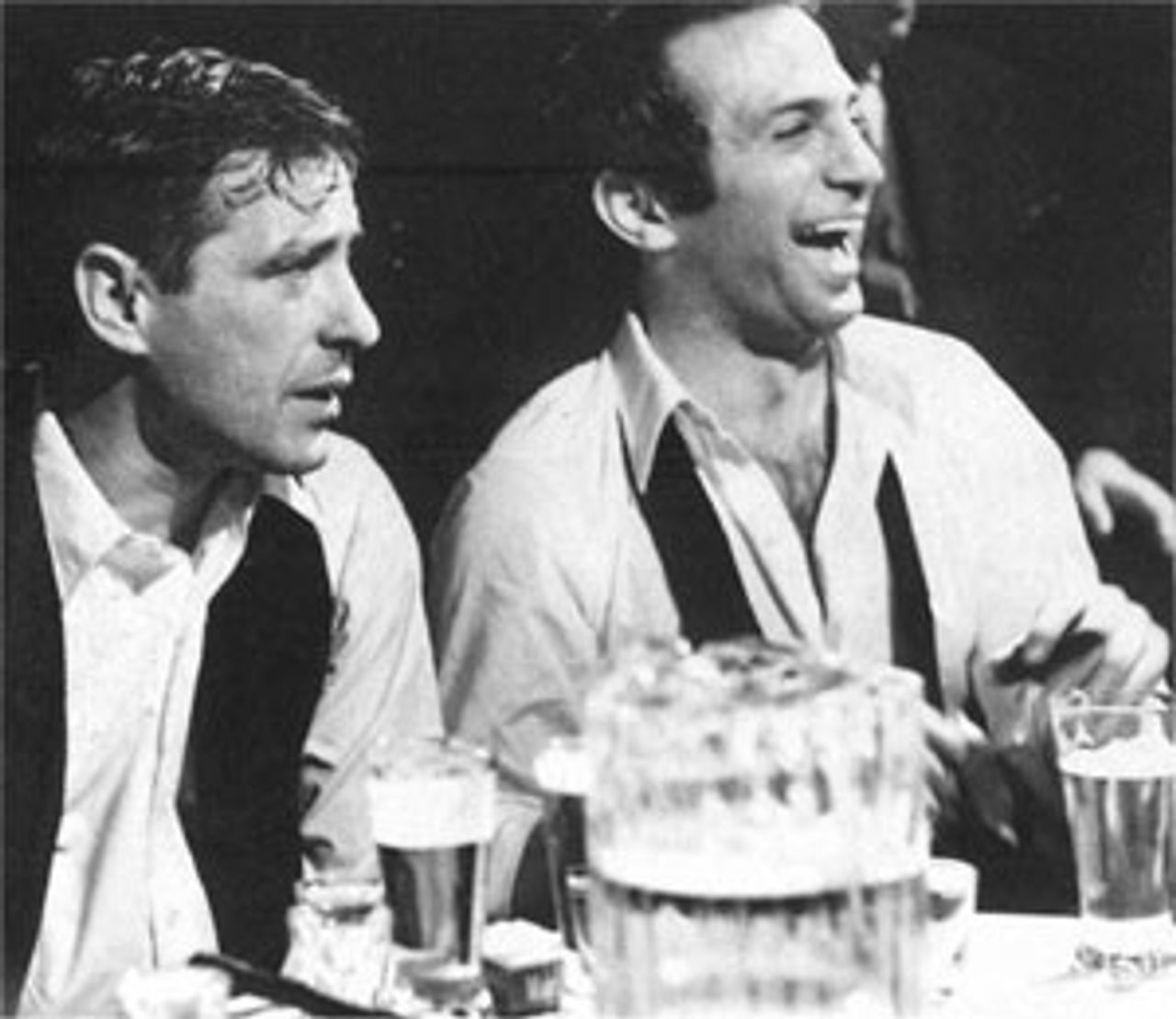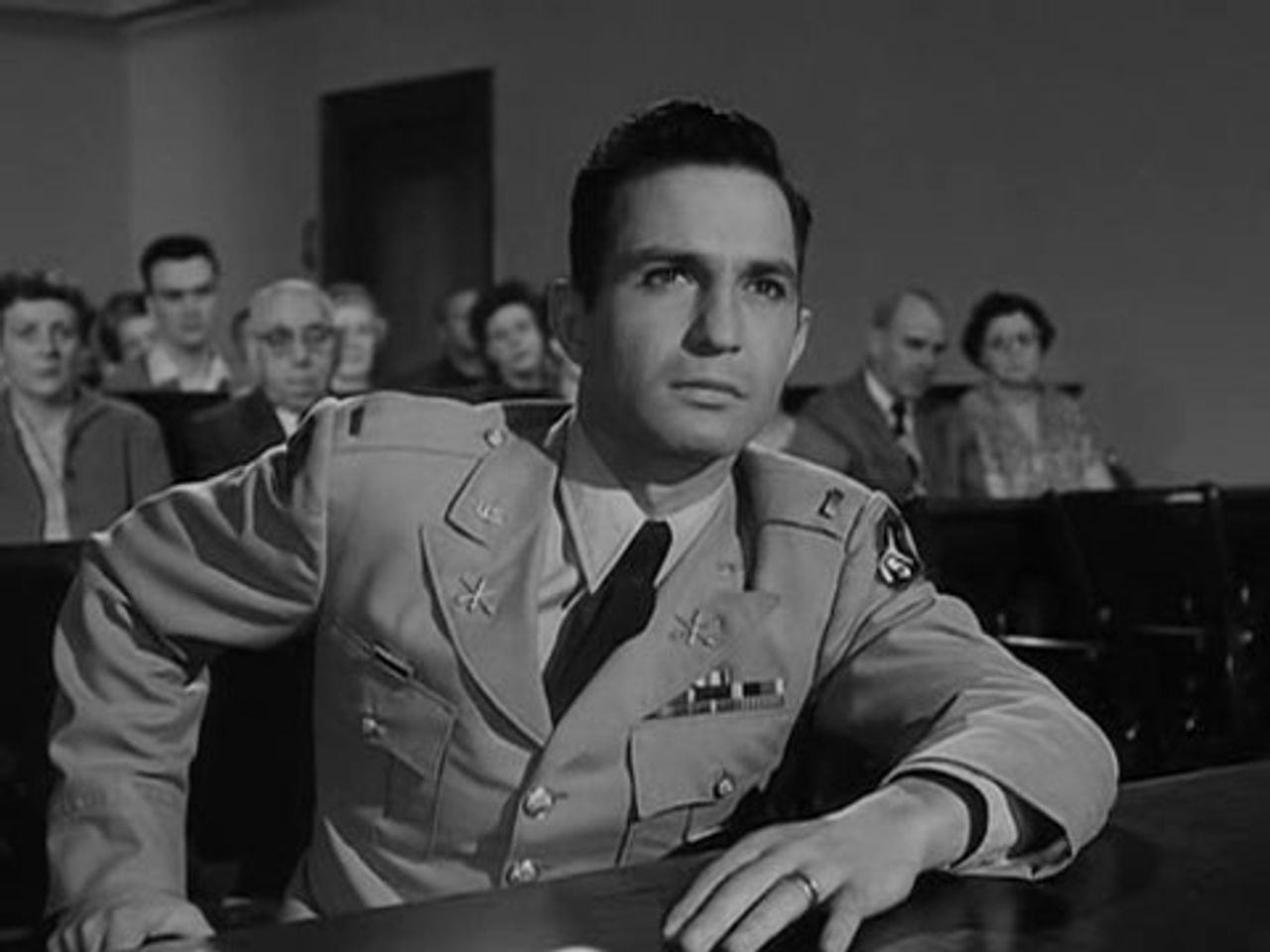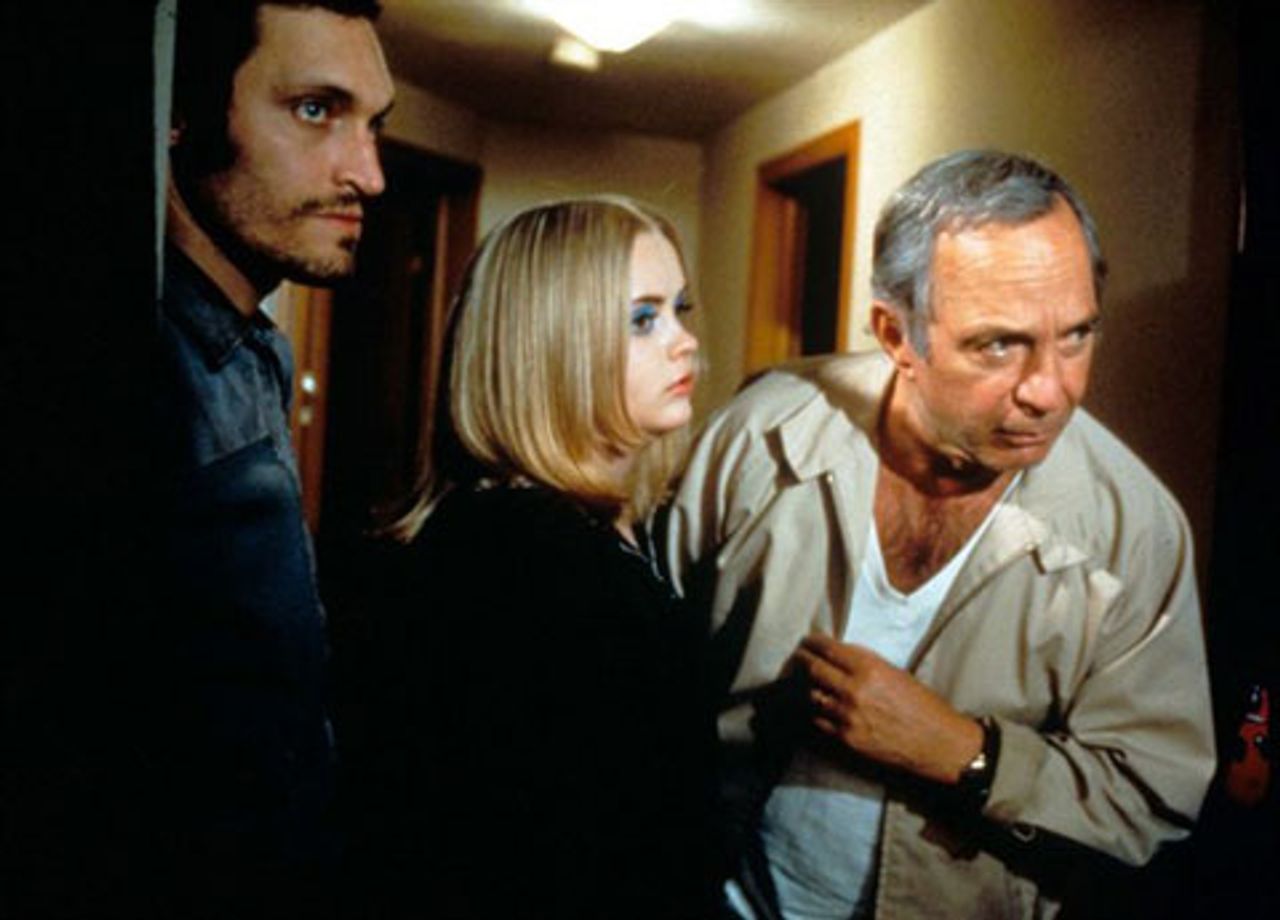American actor Ben Gazzara died February 3 in Manhattan of pancreatic cancer, at the age of 81. Gazzara had survived an earlier bout with cancer that began in 1999.
The performer had a career that stretched from the mid-1950s to the present day, with more than 130 credits to his name. Gazzara is associated in particular with the style of postwar acting and drama identified with the Actors Studio, so-called “Method acting” (based, to one extent or another, on the teaching and practice of Constantin Stanislavski and advocated in the US by Lee Strasberg) and American filmmaking as it emerged from the breakdown of the Hollywood studio system in the 1960s and 1970s.
Independent filmmaker John Cassavetes (1929-1989) was an especially important figure for Gazzara, who appeared in three of the writer-director’s films, Husbands (1970), The Killing of a Chinese Bookie (1976) and Opening Night (1977).
 Cassavetes and Gazzara in Husbands
Cassavetes and Gazzara in HusbandsGazzara’s intensity and his unusual combination of toughness and sensitivity attracted directors for more than half a century. Among the film directors he worked with, in addition to Cassavetes, were Otto Preminger, Mario Monicelli, Franklin J. Schaffner, Phil Karlson, Stuart Rosenberg, Peter Bogdanovich, David Mamet, Vincent Gallo, the Coen brothers, Todd Solondz, John Turturro, Spike Lee, Mira Nair, Lars von Trier and Sergey Bondarchuk. Not all of them served him well, but there is no indication that Gazzara ever gave less than a wholehearted performance.
The future actor was born in Manhattan to parents who were immigrants from Sicily. His father, who dreamed of returning to Italy all his life, earned money “laying asphalt, brick, doing carpentry or any other job he could get,” according to Gazzara in his informative autobiography, In the Moment (2004).
In that book, he explains that his parents bought a building on East Twenty-Ninth Street, “with every penny they’d saved…just three months before the famous stock market crash [in 1929], and in the long and terrible Depression that followed, their dream of striking it rich in America was crushed. They could never break even.”
Gazzara told an interviewer in 1998, “Immigrant Italians weren’t geared toward literature, so movies were our novels, and I grew up on the best: Cagney, Bogart, Cary Grant, Gable, Wallace Beery—wonderful actors.” He did his first amateur acting at 12, and, after graduating from Stuyvesant High School, entered the Dramatic Workshop in New York, headed by the left-wing German émigré, Erwin Piscator, a one-time collaborator with Bertolt Brecht.
In 1951, he auditioned for the Actors Studio, where Strasberg was a leading light and which had already produced Marlon Brando and Julie Harris, among others. The anti-communist hysteria was at its height, and not long after Gazzara was accepted at the Actors Studio, Elia Kazan, a major figure at the school, turned informer. Gazzara writes, “It would be fair to say that the political views of the membership were left of center. So were mine, for that matter. You couldn’t find one person who approved of what Kazan had done.… Our hero was a stool pigeon.”
And yet, and this reveals a good deal about the contradictions of the time, none of the actors resigned from the Actors Studio, as Arthur Miller apparently urged them to do, and Gazzara would later be directed by Kazan on Broadway as Brick in Tennessee Williams’s Cat on a Hot Tin Roof (Paul Newman played the part in the film version).
Film and theater in America in the postwar years were complex phenomena. Despite the fierce purges of left-wing figures in Hollywood, the essential tenor of the movies and drama of the time remained generally leftist or liberal. Directly or indirectly, the problem of fascism and right-wing totalitarianism understandably remained on many minds, even when such concerns emerged in coded fashion in Westerns, science fiction or gangster films, along with such issues as racism and anti-Semitism.
A certain type of intimate realism, fueled by the interest in Stanislavski and other figures, flourished, at the same time as the larger social and historical questions, including any challenges to the legitimacy of American democratic imperialism, were thoroughly excluded. Gazzara matured in this atmosphere, which made possible a body of serious and interesting work, but proved too narrow and restricted a basis for truly breathtaking or liberating films, plays and television shows.
Gazzara worked with and befriended many interesting figures in the theater and film world in New York in the 1950s, including James Dean, Marilyn Monroe, Sidney Lumet, Martin Ritt, Elaine Stritch, Shelley Winters, Barbara Bel Geddes, Marlene Dietrich and Eva Gabor. Nor is he shy about mentioning any of their names in his memoir! In 1958, he met Janice Rule, the talented and underrated actress, and they would later marry.
 Anatomy of a Murder
Anatomy of a MurderHis film breakthrough came in 1959, with Anatomy of Murder, directed by Otto Preminger. The film was based on a book by Michigan Supreme Court Justice and former defense lawyer John D. Voelker, about a murder that took place in Michigan’s Upper Peninsula in 1952. An army lieutenant murdered a local man, believing that the latter had raped his wife. Voelker successfully defended the perpetrator, who was found not guilty by reason of insanity.
Gazzara played the fictional version of the soldier, with Lee Remick as his wife, James Stewart as his attorney, George C. Scott as the “big city” prosecutor and Joseph Welch (the lawyer famous for his role in the Army-McCarthy hearings in 1954) as the judge in the case. Eve Arden, Arthur O’Connell, Orson Bean and Murray Hamilton also took part.
From the striking publicity poster designed by Saul Bass to the score by Duke Ellington, Anatomy of a Murder was an announcement, along with a number of other films of the time, that the conformism and stagnation of the 1950s, bound up with the state religion of anti-communism, was at an end. Preminger’s film is detailed, intense, realistic, ugly at times, even sordid, in a manner that was refreshing.
Gazzara turned down a number of significant film roles in the late 1950s. In his autobiography, writing about a later period, he comments, “Superstardom had eluded me; that had not been easy to take. In the fifties, I’d sort of led the way for actors who were offbeat and hard to pigeonhole. A lot of guys who came after me went much further in notoriety and fame and in just plain getting more work.”
When the film offers “weren’t forthcoming” in the early 1960s, Gazzara turned to television and starred in a series called Run for Your Life, about a man with a terminal illness, for three years. In 1968, writer-director John Cassavetes rescued Gazzara from “doing episode after episode” of the series, “one more predictable than the other. Routine, boredom, factory work, for three years,” with a film offer (New Yorker, February 7).
The movie turned out to be Husbands, the story of three suburban New Yorkers (Gazzara, Cassavetes and Peter Falk), who take off for London after the funeral of a friend. Each finds a woman to spend time with, although all the relationships falter or stumble along awkwardly. In the end, two of the men return to their wives and homes, while Gazzara’s character remains in London.
Gazzara told an interviewer that Husbands “saved my life…it was a liberation.” The film has its considerable strengths and equally considerable weaknesses. Cassavetes was a director with a forceful personality, someone incapable of insincere and half-hearted effort. His anti-conformism and spirit of opposition, however, remained amorphous and unfocused throughout his filmmaking career.
In my view, Cassavetes’s finest film by far was his second feature, Faces (1968), and the most outstanding performances in any of his films, as heretical as this may sound, were turned in on that occasion by Lynn Carlin, John Marley, Seymour Cassel and Val Draper. A genuine sense of dissatisfaction and restlessness, as well as the banality and triviality of so many of the trappings of American middle-class existence, powerfully pervades the work.
Even by the time of the making of Husbands, in my opinion, Cassavetes was already drifting somewhat self-indulgently and that drifting would only become more pronounced throughout the 1970s and into the 1980s. The first cut of Husbands ran four hours long and even at the 138 minutes of the version released in the theaters, the film rambles at times quite tediously, although there are also some exquisite and moving moments.
In any event, these things are also relative. Given the state of American filmmaking at the time, Cassavetes was unquestionably one of the most interesting figures around. Gazzara had the lead role in Cassavetes’s The Killing of a Chinese Bookie (1976), about a small-time strip club owner coerced and tricked into taking on the assignment of killing a figure in the Chinese mafia. The film is more incoherent and at times irritating than Husbands, although again not without its compensations.
Gazzara told a French interviewer in 1995 that Chinese Bookie was a more difficult film to make than Husbands because “I didn’t really understand where John was going with it. I didn’t see right away that the film was a metaphor that meant a lot to him. That these gangsters (Timothy Carey, Seymour Cassel) represented everything that comes along that interferes with, disturbs creativity, the sensibility of an artist; that the film talks about the price to be paid for following your dreams to the end. When I understood this, I took great pleasure in acting in the film, which is less directly accessible than Husbands” (New Yorker).
Gazzara makes clear in his memoir that he considers his association with Cassavetes the most artistically important of his life. He told the French interviewer that “John created a free environment that allowed you to try new things. An actor himself, he understood the problems of actors. He knew how to shake you out of your habits, out of a too structured approach. He liked to be surprised and he was more interested by the behavior of the characters than in the story” (Libération).
In 1979, Gazzara appeared in Peter Bogdanovich’s Saint Jack, about an American hustler in Singapore, and starred in another of Bogdanovich’s efforts, They All Laughed, two years later.
During much of the 1980s, with roles again scarce in the US, Gazzara worked (and lived) in Italy, most notably perhaps in Marco Ferreri’s Tales of Ordinary Madness (1981), based on the book by Charles Bukowski.
Cassavetes’s death in February 1989 propelled Gazzara into a “deep depression,” although the filmmaker’s demise was surely not the only factor. The actor admits in his memoir to periods of despondency throughout his life, and occasional thoughts of suicide. The generally unappetizing state of the film industry cannot have been much of a help.
 Buffalo '66
Buffalo '66Gazzara enjoyed something of a comeback in the late 1990s, although no longer in leading roles. He performed memorably in Vincent Gallo’s Buffalo ’66, the Coen brothers’ The Big Lebowski and Todd Solondz’s Happiness, all released in 1998. He also appeared in films directed by David Mamet, Mira Nair, Spike Lee, Lars von Trier and Sergey Bondarchuk, and continued working throughout the first decade of the twenty-first century, in US, Italian and Russian productions. At the time of his death last week, two of his films had yet to be released.
Gazzara’s intelligence, wry humor and intensity will be sorely missed.
